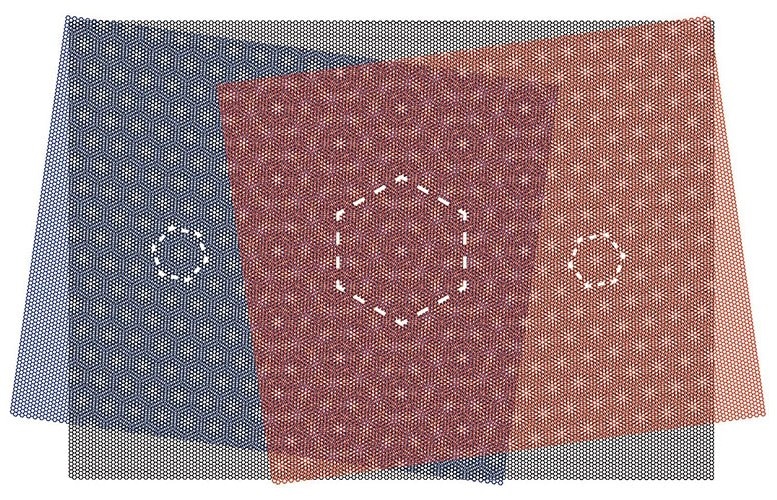Mar 11 2019
Generally, the electrical properties of atomically thin graphene and a boron nitride layer change when these materials are combined at a slightly rotated angle.
 A graphene layer (black) of hexagonally arranged carbon atoms is placed between two layers of boron nitride atoms, which are also arranged hexagonally with a slightly different size. The overlap creates honeycomb patterns in various sizes. (Image credit: Swiss Nanoscience Institute, University of Basel).
A graphene layer (black) of hexagonally arranged carbon atoms is placed between two layers of boron nitride atoms, which are also arranged hexagonally with a slightly different size. The overlap creates honeycomb patterns in various sizes. (Image credit: Swiss Nanoscience Institute, University of Basel).
Now, for the first time, physicists from the University of Basel have demonstrated that the combination with a third layer can also lead to novel material properties in a three-layer sandwich of boron nitride and carbon. This method considerably improves the number of potential artificial materials, reported the physicists in the scientific journal, Nano Letters.
In the previous year, the US researchers caused a major stir when they demonstrated that graphene becomes a superconductor when two stacked graphene layers are rotated by a “magical” angle of 1.1 degrees, a remarkable example of how completely new electrical properties can be produced by combining atomically thin materials.
Precision alignment
Now, this concept has been taken one step further by researchers at the Swiss Nanoscience Institute and the Department of Physics at the University of Basel. The team placed a graphene layer between a pair of boron nitride layers, which usually helps in protecting the structure of sensitive carbon. Doing so, the researchers aligned the layers extremely accurately with the graphene’s crystal lattice.
The impact noticed by the physicists in Professor Christian Schönenberger’s group is often referred to as a moiré pattern: that is, the superimposition of two standard patterns results in a new pattern that has a larger periodic lattice.
New three-layer superlattice
The effects of this type of superlattice were also observed by Lujun Wang, a researcher in Schönenberger’s team and a member of the SNI PhD School, when he integrated graphene and boron nitride layers. The atoms are hexagonally arranged in all layers; stacking them on top of one another results in larger regular patterns, with a size based on the angle between the layers.
It had already been demonstrated that while this works with a two-layer combination of boron nitride and graphene, the effects caused by the second layer of boron nitride is yet to be found.
When the University of Basel physicists tested with three layers, a couple of superlattices were respectively formed between the graphene and the upper and lower layer of boron nitride. When all the three layers were superimposed, it resulted in an even bigger superstructure than possible with just a single layer alone.
Researchers are extremely interested in such kinds of synthetic materials, because the varied moiré patterns can be applied to modify or artificially create innovative electronic material properties.
To put it simply, the atomic patterns determine the behavior of electrons in a material, and we are combining different naturally occurring patterns to create new synthetic materials. Now we have discovered effects in these tailor-made electronic devices that are consistent with a three-layer superstructure.
Dr Andreas Baumgartner, Project Supervisor, University of Basel
Moire 2hBN zoomed intermediate
Moire 2hBN zoomed intermediate theta1 0 to 10 degrees, theta2 3 degrees (converted). (Video credit: Swiss Nanoscience Institute, University of Basel)